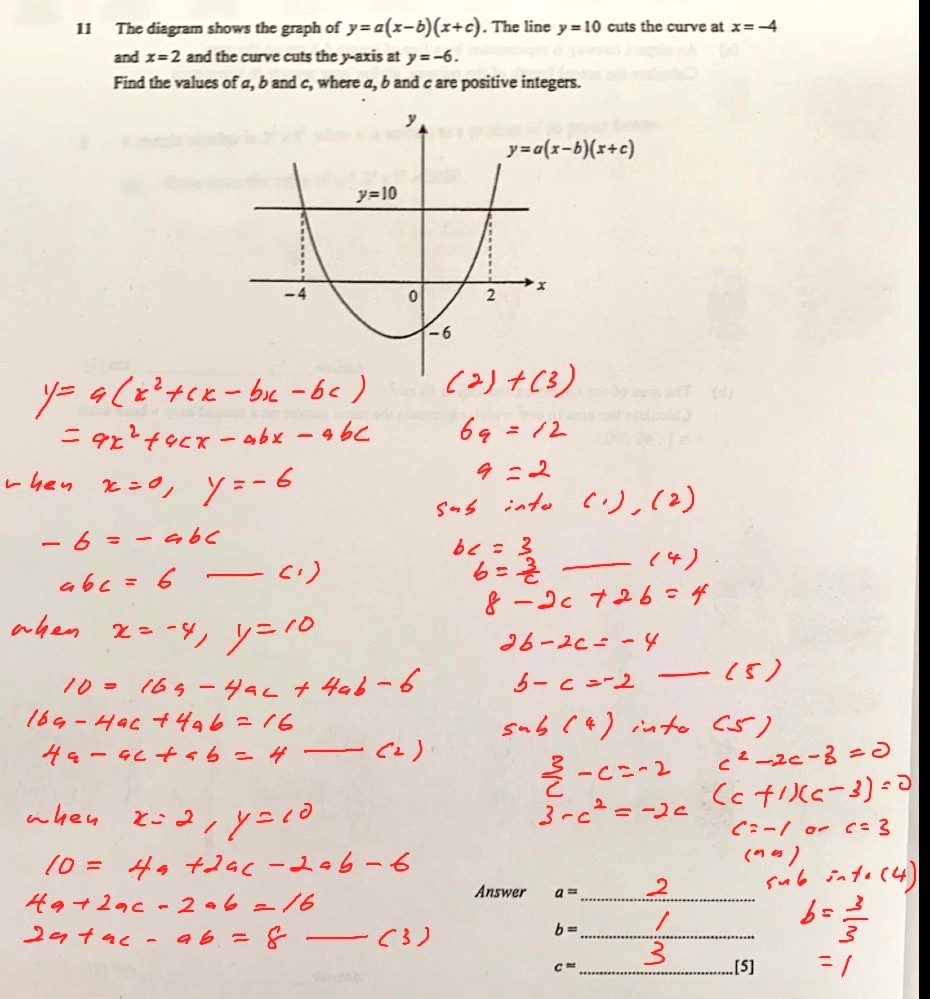Ask Singapore Homework?
Upload a photo of a Singapore homework and someone will email you the solution for free.

See 3 Answers
done
{{ upvoteCount }} Upvotes
clear
{{ downvoteCount * -1 }} Downvotes
One possible approach. The other is plain substitution of
1. x = -4, y = 10
2. x = 0, y = -6
3. x = 2, y = 10
into the equation and solving simuls as wel.
1. x = -4, y = 10
2. x = 0, y = -6
3. x = 2, y = 10
into the equation and solving simuls as wel.
Date Posted:
4 years ago
Thank you sir
For this one I recommend you to use the format ax2 + bx + c instead of the given equation. Else three simuls in three unknowns is going to be tedious to solve.
done
{{ upvoteCount }} Upvotes
clear
{{ downvoteCount * -1 }} Downvotes
Hi, I provide 1 to 1 tuition, $40/1.5h, can cover English / Maths / Science, ex-school teacher with more than 20 years of teaching experience, can produce teaching cert from NIE, WhatsApp 9033 8810 or email [email protected] :)
Date Posted:
3 years ago
done
{{ upvoteCount }} Upvotes
clear
{{ downvoteCount * -1 }} Downvotes
This should be easier to understand
Date Posted:
4 years ago
Yes second one is easy
To add,
There are three formats to consider.
1. y = ax² + bx + c
2. y = a (x + b) (x + c)
3. y = a (x + h)^2 + k
Which is the best approach to use, or are there times where one approach is preferred?
---------------------------------------------
1. y = ax² + bx + c
This approach is preferred when the y-intercept of the graph is provided and two other points on the curve are provided, as is the case in this question.
If (0, -6) is a point on the curve, then c = -6.
We use the other two points (-4, 10) and (2, 10) to form two simuls in two unknowns and solve.
---------------------------------------------
2. y = a (x + b) (x + c)
This approach is preferred when the TWO x-intercepts are provided and one more point is provided.
Suppose the x-intercepts are -3 and 1. Then we have y = a (x + 3) (x - 1). We use the third coordinate to obtain the value of a.
---------------------------------------------
3. y = a (x + h)^2 + k
This approach is preferred when the turning point of the curve is provided and one other point is provided.
If the turning point of the curve is (-1, -8), then by default, h = 1 and k = -8.
Now we have one unknown a left, and we just need one other coordinate (0, -6) to obtain the value of a.
There are three formats to consider.
1. y = ax² + bx + c
2. y = a (x + b) (x + c)
3. y = a (x + h)^2 + k
Which is the best approach to use, or are there times where one approach is preferred?
---------------------------------------------
1. y = ax² + bx + c
This approach is preferred when the y-intercept of the graph is provided and two other points on the curve are provided, as is the case in this question.
If (0, -6) is a point on the curve, then c = -6.
We use the other two points (-4, 10) and (2, 10) to form two simuls in two unknowns and solve.
---------------------------------------------
2. y = a (x + b) (x + c)
This approach is preferred when the TWO x-intercepts are provided and one more point is provided.
Suppose the x-intercepts are -3 and 1. Then we have y = a (x + 3) (x - 1). We use the third coordinate to obtain the value of a.
---------------------------------------------
3. y = a (x + h)^2 + k
This approach is preferred when the turning point of the curve is provided and one other point is provided.
If the turning point of the curve is (-1, -8), then by default, h = 1 and k = -8.
Now we have one unknown a left, and we just need one other coordinate (0, -6) to obtain the value of a.
Take note of these as it simplifies your workings greatly.
Thank you for going the extra mile to help me out. Thank you so mucb







